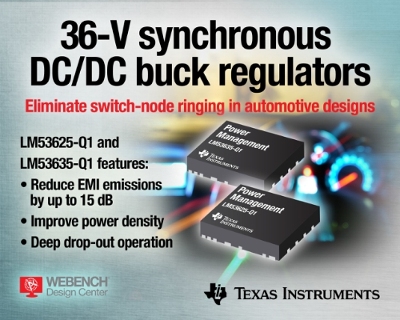36-V, 2.1-MHz regulators enable designers to meet tough requirements such as low EMI, high power density and deep drop-out conditions
DALLAS, June 27, 2016 /PRNewswire/ — Texas Instruments (TI) (NASDAQ: TXN) today introduced two 36-V, 2.1-MHz synchronous buck regulators that eliminate switch-node ringing to reduce electromagnetic interference (EMI), improve power density, and operate in deep drop-out conditions. The 2.5-A LM53625-Q1 and 3.5-A LM53635-Q1 regulators are designed for high-voltage DC/DC step-down applications such as automotive infotainment, high-end cluster, advanced driver assistance systems (ADAS) and body power-supply systems. Wettable flank packaging enables optical inspection to reduce manufacturing costs. By using these step-down regulators together with TI’s WEBENCH® Automotive Design tool, engineers can get their automotive designs to market faster. For more information, samples and an evaluation module, see www.ti.com/lm53635q1-pr.
Switch node ringing is inherent in all switch-mode power supplies. By reducing parasitic inductance and capacitance in the LM53625-Q1 andLM53635-Q1 regulators, these power solutions lower noise and EMI emissions by up to 15 dB at the system level, which requires less external EMI filtering, saves printed circuit board (PCB) area and simplifies compliance with CISPR 25 automotive EMI requirements. Watch avideo that demonstrates how to solve automotive EMI, thermal and system challenges with TI’s LM53635-Q1.
LM53625-Q1 and LM53635-Q1 key features and benefits
- Wide 3.5-V to 42-V operating range handles start-stop and load-dump conditions for 12-V lead acid automotive batteries. Read the blog post, “What to consider when designing an automotive power supply.”
- Provides up to 93 percent efficiency at 2.1-MHz operation to support compact and high-temperature conditions in automotive applications.
- Low 18-uA quiescent current (IQ) in standby extends battery life in “always on” applications.
- Wettable flank packaging enables post-solder optical inspection. Read the blog post, “The value of wettable flank-plated QFN packaging for automotive applications.”
- Deep drop-out performance of less than 0.6 V under full load and temperature conditions enables compliance with stringent cold-crank and start-stop conditions, saving system cost and solution size.
The LM53625-Q1 and LM53635-Q1 join the recently released LM53600-Q1, LM53601-Q1, LM53602-Q1, LM53603-Q1 and LM5140-Q1 buck converters to create a complete family of controllers and regulators designed for automotive systems that draw less than 0.65 A of power to more than 10 A. All of these devices feature greater than 2-MHz switching frequency, low operating IQ and EMI reduction features.
Create an automotive infotainment power system
Download the “Infotainment Power System Reference Design for Automotive” to view a full off-battery front-end power supply for automotive infotainment systems. The reference design includes the LM53635-Q1 regulator, LM27313-Q1 boost converter and LM74610-Q1 smart diode controller. The reference design meets all industry tests including ISO 7637 pulse, cold crank, reverse battery, input over-voltage and CISPR 25 Class 5-conducted EMI.
Availability, packaging and pricing
The new DC/DC regulators are available in volume now from TI and its authorized distributors. Offered in a 22-pin, 4-mm-by-5-mm very thin quad flat no-lead (VQFN) package, the LM53625-Q1 is priced at US$2.79 in 1,000-unit quantities and the LM53635-Q1 is priced at US$3.22. Order the LM536253QEVM evaluation module and download a PSpice transient model.
Find out more about TI’s power-management portfolio:
- Get more information on TI’s DC/DC regulator portfolio for any power-supply application.
- Search for solutions, get help and share knowledge in the TI E2E™ Community Power Management forum.
- Download power reference designs from the TI Designs reference design library.



















